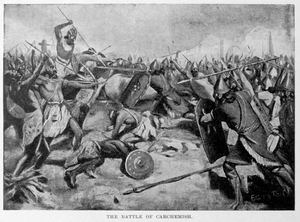Battle of Carchemish
| Battle of Carchemish | |||||||
|---|---|---|---|---|---|---|---|
| Part of the Egyptian–Babylonian wars | |||||||
 The Battle of Carchemish, as depicted in Hutchinson's Story of the Nations (1900) | |||||||
| |||||||
| Belligerents | |||||||
|
Egypt Remnants of the army of the former Assyria |
Babylonia Medes, Persians, Scythians (?)[1][2] | ||||||
| Commanders and leaders | |||||||
| Necho II |
Nebuchadnezzar II Cyaxares(?) | ||||||
| Strength | |||||||
| 40,000 | 18,000 | ||||||
| Casualties and losses | |||||||
| large | minimal | ||||||
The Battle of Carchemish was fought about 605 BC[3][4][5] between the armies of Egypt allied with the remnants of the army of the former Assyrian Empire against the armies of Babylonia, allied with the Medes, Persians, and Scythians.This battle is also mentioned in Ezekiel chapter 30 in the Bible.
Background
When the Assyrian capital Nineveh was overrun by the Medes, Scythians, Babylonians and their allies in 612 BC, the Assyrians moved their capital to Harran. When Harran was captured by the alliance in 609 BC,[6] ending the Assyrian Empire, remnants of the Assyrian army joined Carchemish, a city under Egyptian rule, on the Euphrates river. Egypt (a former vassal of Assyria) was allied with the Assyrian king Ashur-uballit II, and marched in 609 BC to his aid against the Babylonians.[7]
The Egyptian army of Pharaoh Necho II was delayed at Megiddo by the forces of King Josiah of Judah. Josiah was killed, and his army was defeated at the Battle of Megiddo (609 BC).
The Egyptians and Assyrians together crossed the Euphrates and laid siege to Harran, which they failed to retake. They then retreated to north western Assyria (in what is today north eastern Syria).
Battle
The Egyptians met the full might of the Babylonian and Median army led by Nebuchadnezzar II at Carchemish, where the combined Egyptian and Assyrian forces were destroyed. Assyria ceased to exist as an independent power, and Egypt retreated and was no longer a significant force in the Ancient Near East. Babylonia reached its economic peak after 605 BC.[8]
Records of the battle
The Nebuchadnezzar Chronicle, now housed in the British Museum, claims that Nebuchadnezzar "crossed the river to go against the Egyptian army which lay in Karchemiš. They fought with each other and the Egyptian army withdrew before him. He accomplished their defeat, decisively. As for the rest of the Egyptian army which had escaped from the defeat so quickly that no weapon had reached them, in the district of Hamath, the Babylonian troops overtook and defeated them so that not a single man escaped to his own country. At that time, Nebuchadnezzar conquered the whole area of Hamath."[9]
The battle is also mentioned and described in the Bible, in the Book of Jeremiah.[10] The battle mentioned in 2 Chronicles 35:20-27 is not the same; the event referred to there is the Battle of Megiddo (609 BC), which occurred four years earlier, also near Carchemish (2 Chronicles 35:20).
Discrepancy
However, it is unclear historically if Pharaoh Necho II was for or against the king of Assyria, according to Flavius Josephus in his record Antiquities of the Jews[11] and various Christian commentators, such as Matthew Henry[12] and John Peter Lange.[13] Such accounts render the battle as King Josiah either heroically trying to rescue the Assyrians from their enemies or attempting to avoid being surrounded by an enemy.
See also
Notes
- ^ Neciyev, Elnur. "The Cambridge History of Iran. Volume 2: The Median And Achaemenian Periods. edited by Ilya Gershevitch. Cambridge University Press, 1985. 929 pp": 124.
{{cite journal}}: Cite journal requires|journal=(help) - ^ Encyclopedia Iranica "After the fall of Ḥarran, the strategic center of Assyrian resistance was moved to Carchemish, a city on the Upper Euphrates, which at that time belonged to Egypt. Carchemish was captured by the Babylonians in 605 BCE. It is not clear whether the Medes also participated in this final defeat of the Assyrians"
- ^ Horn, Siegfried H (1967). "THE BABYLONIAN CHRONICLE AND THE ANCIENT CALENDAR OF THE KINGDOM OF JUDAH". Andrews University Seminary Studies (5/1967): 20. Archived from the original on 2015-09-23. Retrieved 4 August 2014.
- ^ Wiseman, D. J. (1956). Chronicles of Chaldaean Kings (626-556 B.C.). British Museum: British Museum Publications, Ltd. p. 99.
- ^ British Museum. "Cuneiform tablet with part of the Babylonian Chronicle (605-594 BC)". britishmuseum.org. Archived from the original on 2014-10-30. Retrieved 4 August 2014.
- ^ Grant, R.G. (2005). Battle: A Visual Journey Through 5,000 Years of Combat. London: Dorling Kindersley. p. 18.
- ^ Georges Roux, Ancient Iraq
- ^ King, Philip J., 1993 Jeremiah: An Archaeological Companion, Westminster/John Knox Press p.22 [1]
- ^ Chronicle Concerning the Early Years of Nebuchadnezzar II. Retrieved July 18, 2010.
- ^ The Bible, Jeremiah 46:3–12
- ^ "Flavius Josephus, Antiquities of the Jews, Book 10, Whiston chapter 5, Whiston section 1". www.perseus.tufts.edu. Retrieved 2017-12-07.
- ^ "2 Kings 23 Commentary - Matthew Henry Commentary on the Whole Bible (Complete)". Bible Study Tools. Retrieved 2017-12-07.
- ^ "2 Kings 22 Lange Commentary on the Holy Scriptures". www.biblehub.com. Retrieved 2017-12-07.
